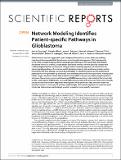| dc.contributor.author | Pokorny, Jenny L. | |
| dc.contributor.author | Sio, Terence T. | |
| dc.contributor.author | Iyekegbe, Dennis O. | |
| dc.contributor.author | Sarkaria, Jann N. | |
| dc.contributor.author | Tuncbag, Nurcan | |
| dc.contributor.author | Milani, Pamela | |
| dc.contributor.author | Johnson, Hannah | |
| dc.contributor.author | Dalin, Simona | |
| dc.contributor.author | Fraenkel, Ernest | |
| dc.contributor.author | White, Forest M. | |
| dc.date.accessioned | 2017-01-20T15:35:47Z | |
| dc.date.available | 2017-01-20T15:35:47Z | |
| dc.date.issued | 2016-06 | |
| dc.date.submitted | 2016-02 | |
| dc.identifier.issn | 2045-2322 | |
| dc.identifier.uri | http://hdl.handle.net/1721.1/106550 | |
| dc.description.abstract | Glioblastoma is the most aggressive type of malignant human brain tumor. Molecular profiling experiments have revealed that these tumors are extremely heterogeneous. This heterogeneity is one of the principal challenges for developing targeted therapies. We hypothesize that despite the diverse molecular profiles, it might still be possible to identify common signaling changes that could be targeted in some or all tumors. Using a network modeling approach, we reconstruct the altered signaling pathways from tumor-specific phosphoproteomic data and known protein-protein interactions. We then develop a network-based strategy for identifying tumor specific proteins and pathways that were predicted by the models but not directly observed in the experiments. Among these hidden targets, we show that the ERK activator kinase1 (MEK1) displays increased phosphorylation in all tumors. By contrast, protein numb homolog (NUMB) is present only in the subset of the tumors that are the most invasive. Additionally, increased S100A4 is associated with only one of the tumors. Overall, our results demonstrate that despite the heterogeneity of the proteomic data, network models can identify common or tumor specific pathway-level changes. These results represent an important proof of principle that can improve the target selection process for tumor specific treatments. | en_US |
| dc.description.sponsorship | National Cancer Institute (U.S.) (U54CA112967 and U01CA184898) | en_US |
| dc.description.sponsorship | Institute for Collaborative Biotechnologies (Grant W911NF-09-0001) | en_US |
| dc.description.sponsorship | United States. Army Research Office | en_US |
| dc.language.iso | en_US | |
| dc.publisher | Nature Publishing Group | en_US |
| dc.relation.isversionof | http://dx.doi.org/10.1038/srep28668 | en_US |
| dc.rights | Creative Commons Attribution 4.0 International License | en_US |
| dc.rights.uri | http://creativecommons.org/licenses/by/4.0/ | en_US |
| dc.source | Nature | en_US |
| dc.title | Network Modeling Identifies Patient-specific Pathways in Glioblastoma | en_US |
| dc.type | Article | en_US |
| dc.identifier.citation | Tuncbag, Nurcan et al. “Network Modeling Identifies Patient-Specific Pathways in Glioblastoma.” Scientific Reports 6 (2016): 28668. | en_US |
| dc.contributor.department | Massachusetts Institute of Technology. Department of Biological Engineering | en_US |
| dc.contributor.department | Massachusetts Institute of Technology. Department of Biology | en_US |
| dc.contributor.department | Koch Institute for Integrative Cancer Research at MIT | en_US |
| dc.contributor.mitauthor | Tuncbag, Nurcan | |
| dc.contributor.mitauthor | Milani, Pamela | |
| dc.contributor.mitauthor | Johnson, Hannah | |
| dc.contributor.mitauthor | Dalin, Simona | |
| dc.contributor.mitauthor | White, Forest M | |
| dc.contributor.mitauthor | Fraenkel, Ernest | |
| dc.relation.journal | Scientific Reports | en_US |
| dc.eprint.version | Final published version | en_US |
| dc.type.uri | http://purl.org/eprint/type/JournalArticle | en_US |
| eprint.status | http://purl.org/eprint/status/PeerReviewed | en_US |
| dspace.orderedauthors | Tuncbag, Nurcan; Milani, Pamela; Pokorny, Jenny L.; Johnson, Hannah; Sio, Terence T.; Dalin, Simona; Iyekegbe, Dennis O.; White, Forest M.; Sarkaria, Jann N.; Fraenkel, Ernest | en_US |
| dspace.embargo.terms | N | en_US |
| dc.identifier.orcid | https://orcid.org/0000-0003-0250-0474 | |
| dc.identifier.orcid | https://orcid.org/0000-0001-5024-9718 | |
| dc.identifier.orcid | https://orcid.org/0000-0002-1545-1651 | |
| dc.identifier.orcid | https://orcid.org/0000-0001-9249-8181 | |
| mit.license | PUBLISHER_CC | en_US |
| mit.metadata.status | Complete | |
